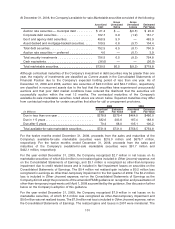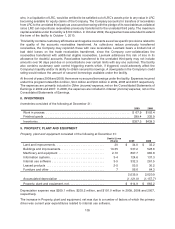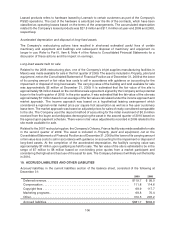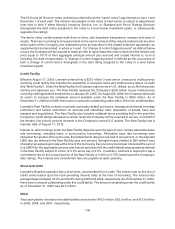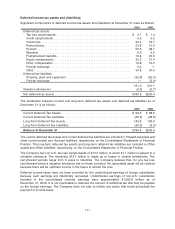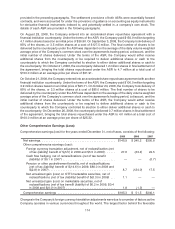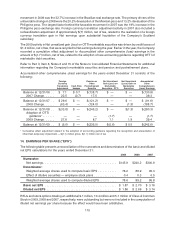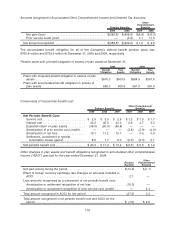Lexmark 2009 Annual Report Download - page 114
Download and view the complete annual report
Please find page 114 of the 2009 Lexmark annual report below. You can navigate through the pages in the report by either clicking on the pages listed below, or by using the keyword search tool below to find specific information within the annual report.The 2013 and 2018 senior notes (collectively referred to as the “senior notes”) pay interest on June 1 and
December 1 of each year. The interest rate payable on the notes of each series is subject to adjustments
from time to time if either Moody’s Investors Service, Inc. or Standard and Poor’s Ratings Services
downgrades the debt rating assigned to the notes to a level below investment grade, or subsequently
upgrades the ratings.
The senior notes contain typical restrictions on liens, sale leaseback transactions, mergers and sales of
assets. There are no sinking fund requirements on the senior notes and they may be redeemed at any time
at the option of the Company, at a redemption price as described in the related indenture agreement, as
supplemented and amended, in whole or in part. If a “change of control triggering event” as defined below
occurs, the Company will be required to make an offer to repurchase the notes in cash from the holders at a
price equal to 101% of their aggregate principal amount plus accrued and unpaid interest to, but not
including, the date of repurchase. A “change of control triggering event” is defined as the occurrence of
both a change of control and a downgrade in the debt rating assigned to the notes to a level below
investment grade.
Credit Facility
Effective August 17, 2009, Lexmark entered into a $275 million 3-year senior, unsecured, multicurrency
revolving credit facility that includes the availability of swingline loans and multicurrency letters of credit
(the “New Facility”). Under the New Facility, the Company may borrow in U.S. dollars, euros, British pounds
sterling and Japanese yen. The New Facility replaced the Company’s $300 million 5-year multicurrency
revolving credit agreement entered into on January 20, 2005. On August 26, 2009, the Company exercised
its option to increase the maximum amount available under the New Facility to $300 million. As of
December 31, 2009 and 2008, there were no amounts outstanding under either of the two credit facilities.
Lexmark’s New Facility contains usual and customary default provisions, leverage and interest coverage
restrictions and certain restrictions on secured and subsidiary debt, disposition of assets, liens and
mergers and acquisitions. The New Facility also includes collateral terms providing that in the event the
Company’s credit ratings decrease to certain levels the Company will be required to secure, on behalf of
the lenders, first priority security interests in the Company’s owned U.S. assets. The New Facility has a
maturity date of August 17, 2012.
Interest on all borrowings under the New Facility depends upon the type of loan, namely alternative base
rate borrowings, swingline loans or eurocurrency borrowings. Alternative base rate borrowings bear
interest at the greater of the prime rate, the federal funds rate plus one-half of one percent, or the adjusted
LIBO rate (as defined in the New Facility) plus one percent. Swingline loans (limited to $50 million) bear
interest at an agreed upon rate at the time of the borrowing. Eurocurrency loans bear interest at the sum of
(i) a LIBOR for the applicable currency and interest period and (ii) the credit default swap spread as defined
in the New Facility subject to a floor of 2.5% and a cap of 4.5%. In addition, Lexmark is required to pay a
commitment fee on the unused portion of the New Facility of 0.40% to 0.75% based upon the Company’s
debt ratings. The interest and commitment fees are payable at least quarterly.
Short-term Debt
Lexmark’s Brazilian operation has a short-term, uncommitted line of credit. The interest rate on this line of
credit varies based upon the local prevailing interest rates at the time of borrowing. The interest rate
averaged approximately 18.2% and 26.8% during 2009 and 2008, respectively. As of December 31, 2009,
there was no amount outstanding under this credit facility. The amount outstanding under the credit facility
as of December 31, 2008 was $5.5 million.
Other
Total cash paid for interest on the debt facilities amounted to $42.5 million, $26.9 million, and $12.6 million
in 2009, 2008, and 2007, respectively.
108





